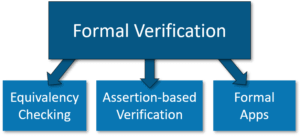
Formal verification is slowly but surely becoming an indispensable tool in the modern verification toolbox. A tool that can increase significantly tape-out confidence and speed up the identification of bugs, hence reducing the cost for fixing them.
Optimally combining formal property proof and formal apps with functional verification (UVM, C based tests etc.) can result in tremendous savings in the overall verification effort of the project and considerable improvements with respect to the quality of the device.
Our team of formal verification experts can support your team to become familiar with the formal verification methodology, identify candidate blocks to apply formal verification, and extend your formal-capable manpower.
When deploying formal verification in the environment of a customer we typically follow the following steps
Initial Consultation
We start by discussing with the customer to understand the target of the activity and define the intended result. Those may be the introduction of formal verification methodology in their group for the first time, reaching formal sign-off for certain blocks, verifying the top-level wiring of an SoC, or even debugging a PostSi failure. We collect the customer’s requirements and prepare for our next meeting a proposal w.r.t. time, budget, and recommended engagement model.
SoW
During our second meeting with the customer, we present our proposal based on the inputs received during our initial consultation. After reaching an agreement with the customer on the specific terms and conditions for the given project, the SoW is signed and the technical side of the activities can begin.
Our team is experienced with all major formal verification tool vendors.
Verification Execution
During the execution of the verification work, our lead consultant will have regular alignments with the customer to discuss project progress and potentially blocking points. Being a metrics-driven company, during those calls typically coverage reports are presented to the customer to showcase the results of the formal verification work being conducted.
The activities are typically concluded by providing to the customer a comprehensive report containing design and/or mutation coverage reports, verification plan coverage, and documentation of the verification environment delivered.